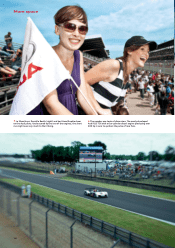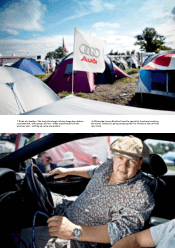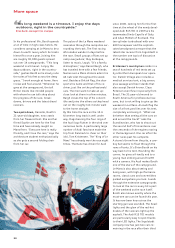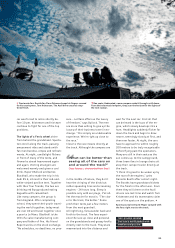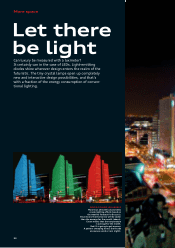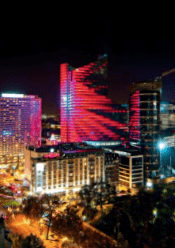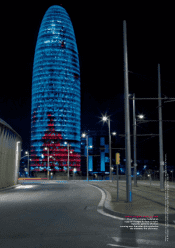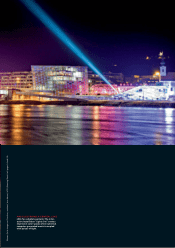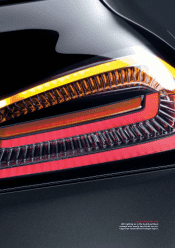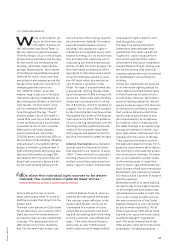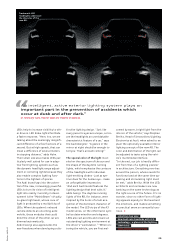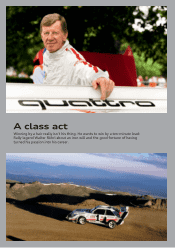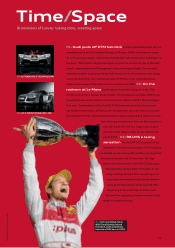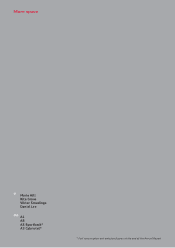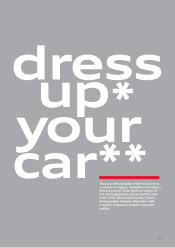Audi 2009 Annual Report Download - page 30
Download and view the complete annual report
Please find page 30 of the 2009 Audi annual report below. You can navigate through the pages in the report by either clicking on the pages listed below, or by using the keyword search tool below to find specific information within the annual report.hat is the weather go-
ing to be like tomorrow
in Brussels? A glance at
the 145-meter-high Dexia Tower in
the city center provides the answer.
If the building is lit up in red at night,
temperatures well above the average
for the month can be expected the
next day, while blue means below-
average temperatures. The forecast
of the Belgian Royal Meteorological
Institute for wind, cloud cover and
precipitation also sweeps across the
facade of the highrise in the form of
changing patterns and colors.
The “Weather Tower” as an XXL
weather map is just one of multiple
interactive lighting installations by
the artist group LAb[au] on the build-
ing’s facade. “Chrono Tower” uses
color to represent the passage of
time throughout the day; “Touch”
allowed passers-by on the street to
create their own colors and patterns
on the building using a touchscreen
connected to the control computer.
Making this oversized, dynamic
screen possible are more than
150,000 green, blue and red LEDs in
the windows of the building. Whether
interactive art or targeted lighting
design, a veritable quantum leap in
light-emitting diode technology (see
technical information on page 28)
has enabled the tiny semiconductor-
based light sources to become a dri-
ver for sophisticated lighting archi-
tecture the world over in recent
years, particularly when it comes to
lighting concepts that stray from the
beaten path.
The wide color palette of LEDs allows
for extraordinary color accents; their
small size and low maintenance re-
quirements open up new possibilities
in design. The latest generation of
LEDs stand out for their durability
and, for the same light output, use
only a fraction of the energy required
by conventional lighting. This makes
even the transformation of entire
buildings into spectacular light in-
stallations an acceptable luxury with
respect to energy. It’s no wonder that
star architects the world over are in-
corporating the nearly endless possi-
bilities of LEDs into their designs. The
New York-based architectural office
Asymptote Architecture used a mesh
of some 5,800 glass panels to cover
the YAS hotel which sits astride the
new Formula 1 racetrack in Abu
Dhabi. At night it is transformed into
a spectacular lighting display made
up of thousands of LEDs shining in all
directions. These little light-emitting
diodes also accentuate the Torre Ag-
bar in Barcelona, which is modeled on
a geyser. The 32-story office complex
by the French builder Jean Nouvel has
highlighted the center of the Spanish
metropolis since 2005. The patterns
of colors moving dynamically over the
building’s surface symbolize the ele-
ments of fire and water associated
with a geyser and appear to free the
building from gravity’s grasp at night.
Internal illumination also character-
izes the new Ars Electronica Center
that opened in Linz, Austria, in early
2009. “I was striving for a sculptural
building whose structure could be
walked on and thus experienced sen-
sually,” says its creator, the Viennese
architect Andreas Treusch, when ex-
plaining the idea behind the design.
This concept is also reflected in the
double-shell facade, which can be
illuminated in a number of colors
using LEDs and joins the new build-
ing and the existing festival building
to form a complex cube of steel and
glass. “This turns the building as a
whole into an over 5,000-square-
meter projection and image surface,
a transparent light sculpture with
high recognition value.”
The New York media artist Zach
Liebermann demonstrated what
possibilities this opens up with his
“Lights On!” audio-visual perform-
ance at the opening of the center.
Liebermann’s interactive installation
coupled flashes of light running over
the entire building with spherical
computer-generated music broadcast
on loudspeakers surrounding the
building.
Artists like Liebermann are pioneers
of an interactive lighting design for
which LEDs are predestined because
of their flexibility in terms of color
and intensity. However, the trend in
practical lighting design for interior
spaces is also moving in the direction
of interactive illumination concepts
that combine natural and artificial
light to adjust dynamically to peo-
ple’s requirements. At workplaces,
for instance, which in keeping with
the latest findings in perception psy-
chology are bathed in indirect, non-
glare light whose intensity and color
changes over the course of the day.
“This supports the natural cycle of
the wake and sleep hormones, for in-
stance by using intense white light in
the morning to stimulate the produc-
tion of serotonin, whereas, for exam-
ple, a room bathed in warmer tones
in the evening tends to signal the
brain to relax,” says Christian Barten-
bach, founder of the world-renowned
Bartenbach Light Laboratory outside
of Innsbruck and a pioneer of modern
lighting planning.
Bartenbach prefers to leave lighting
during the day to the natural dynam-
ics of sunlight and uses natural day-
light whenever possible to light inte-
riors, even in large projects such as
the new construction of the Grand
Egyptian Museum in Cairo. But what
do you do when night falls? “All of
these projects use LEDs whose inten-
sity and color spectrum most closely
resembles daylight,” says Barten-
bach. The small dimensions of the
LEDs are also important to the senior
ambassador of lighting planning,
W
27
“
LEDs allow the individual light sources to be decen-
tralized; the construction material itself shines.”
Christian Bartenbach, pioneer of modern lighting planning
COPY/GEORG RÜSCHEMEYER
Photos: AUDI AG



